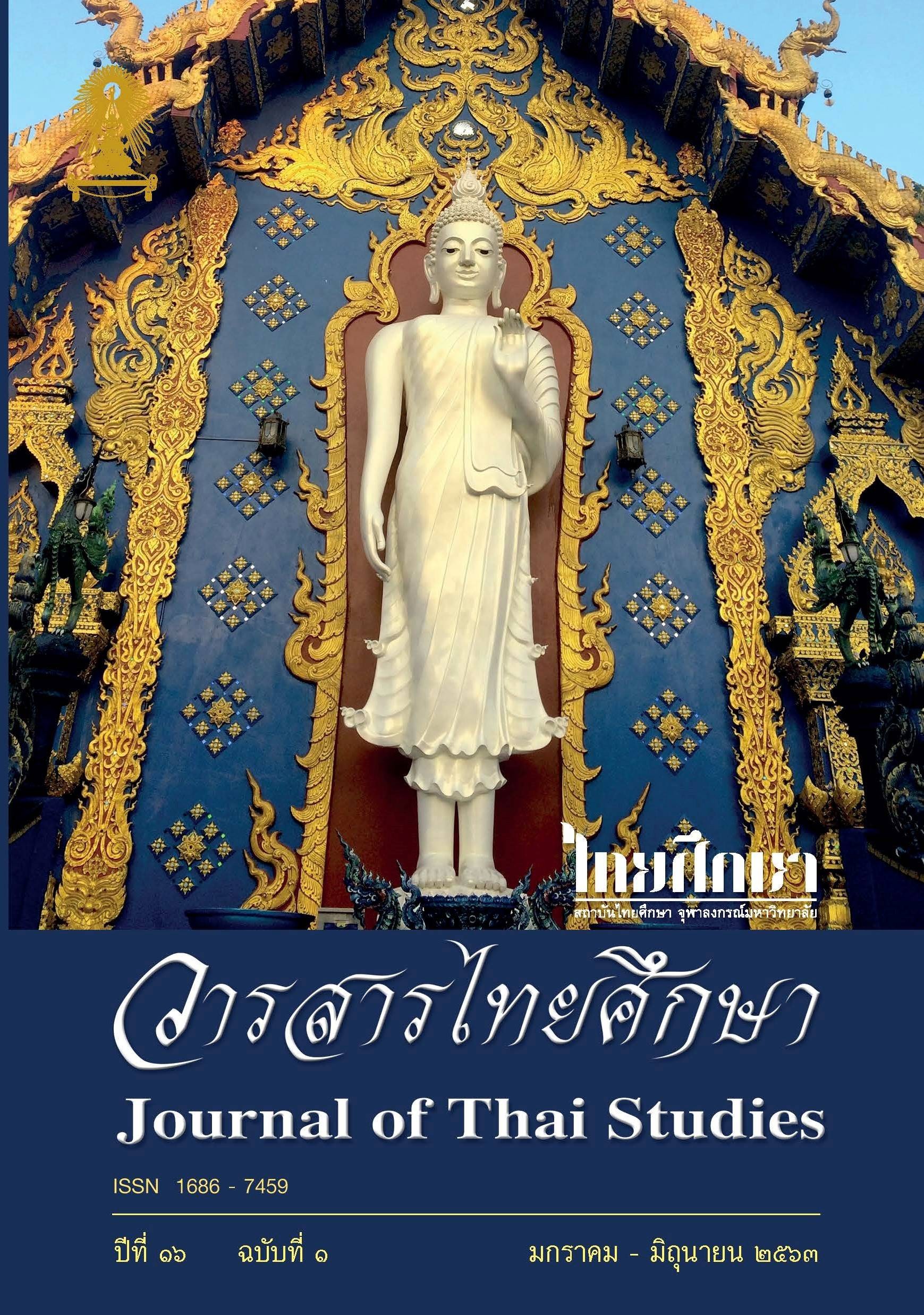Phra-thaen: Buddhism Belief and Thai culture
Main Article Content
Abstract
This article aims to describe the belief of phra-thaen and the Thai way of worship by referring to three pieces of Thai literature: 1) Nirat Phra-thaen Dongrang composed by Novice Klan; 2) Nirat Phra-thaen Dongrang composed by Mr. Mee; and 3) Nirat Luangprabang composed by Luang Thuayhanraksa (Phuem). The results found that there were two phra-thaen – Phra-thaen Dongrang and Pra-thaen Sila-at – that were important Buddhist venues where it is believed that the Lord Buddha visited in his lifetime. Worshipping at these sites has appeared in the form of both practice and material worship, such as fireworks, flowers and amusement, as well as other rituals. Accordingly, the abovementioned literature has retained its importance towards Thai culture regarding Buddhist worship during the Rattanakosin period until the present.
Downloads
Article Details

This work is licensed under a Creative Commons Attribution-NonCommercial-NoDerivatives 4.0 International License.
Journal of Thai studies is licensed under a Creative Commons Attribution-Noncommercial-NoDerivatives4.0 Intenational (CC BY-NC-ND 4.0) licence, unless otherwise stated. Plese read our Policies page for more information on Open Access, copyright and permissions.
References
Chanthramphon, A and Rueangnarong, P. (2012). Nai Mi (Samian Mi) sit ek sunthon phu. [Nai Mi, Student of Sunthorn Phu]. Bangkok: Wasi creation.
Chompoopra, P. (2012). A comparative Study of the Mahaparinibbanasutta and Phranippanasutra. (Master of Arts). Srinakarinwirot University, Bangkok, Thailand.
Chulalongkorn (Rama V), King (1959). Phraratchaniphon Sadet Praphat Sai Yok. [Travels of His Majesty the King to Sai Yok]. Pranakorn: Rungrueangtham.
Chotmaihet sadet phra rat dam noen liap monthon fai nue phra phutthasakkarat 2469. [Archives of traveling along the northern provinces in 1926]. (2015). Bangkok: Amarin printing.
Fine Arts Department. (2013). Prachum wannakhadi rueang Phraphutthabat. [The literature of Phraphutthabat]. Bangkok: Fine Arts Department.
Fine Arts Department. (2015). Nirat Muengluang phra bang lae rai-ngan prap Ngiao. [Nirat Mueangluang phra bang and report on Ngiao]. (4th ed). Bangkok: Fine Arts Department.
Luangchakkrapani, R. (1925). Nirat Phra Pathawi. [Nirat Phra Pathawi]. N.p.: Sophonphipatthanakorn.
Pakdeekam, S. (2015). Phra rat phongsawadan chabap Phra Phonrat wat Phra che tu phon truatsop chamra chak ekkasan tua khian. [Royal chronicles, version of Phra Panarat]. Bangkok: Amarin printing.
Payutto, P. (2008). Photchananukrom phuthasat chabap pramuan sap. [Buddhist Dictionary]. (11th ed). Nonthaburi: S R printing mass products.
Phinthuphan, H. (1978). Uttaradit khong rao. [Our Uttaradit]. Phisanulok: Srinakarinwirot University.
Phra rat phongsawadan chabap phraratchahatthalekha lem 2. [Royal chronicles of Royal Letters, Book 2]. (1992) (8th ed). Bangkok: Fine Arts Department.
Phratraipidok phasa thai chabap sangkhayana nai phraborom rachupatham phutthasakkarat 2530 lem 10. [Thai Tripitaka: The edition of royal patronage of 1987, book 10]. (1987). Bangkok: Kansasana.
Pramuanmak, P. (2010). Prawat kham klon sunthon phu (chabap prapprung). [History of Sunthorn Phu’s poems]. Bangkok: Phimkham.
Royal Institute. (2013). Photchananukrom chabap Ratchabandittayasathan BE 2554. [Dictionary of the Royal Institute, 2011 Edition]. Bangkok: Royal Institute.
Saenkham,T. (2015). Buanphra-ot in Phra Thaen Sila-at Temple. Art and Culture magazine. 36 (9), 146-155.
Sonsiri, K and Akkha, W. (2013). Phra barami pokklao chao Phitsanulok. [The king and the people of Phitsanulok]. Phitsanulok: Rattanasuwan.
Suklek, P. (2017). National Museum Phra Buddha Chinnarat and ancient material about Phra Buddha Chinnarat. Art and Culture magazine. 38 (9), 106-121.
Wachira yan lem 8 phaen thi 16 wan phruhatsabodi thi 26 duen makarakhom rattanakosin sok 111. [Vachirayayan, Book 8, Chapter 16]. (1892). N.p.
Wat phra thaen dong rang. [Phra Thaen Dong Rang Temple]. (1979). Bangkok: Sirimit
Wongsutthitham, N. (2006). Wannakam Nirat. [Nirat literature]. (4th ed). Bangkok: Ramkhamhaeng University Publishing.


